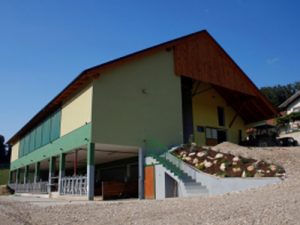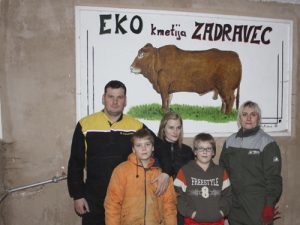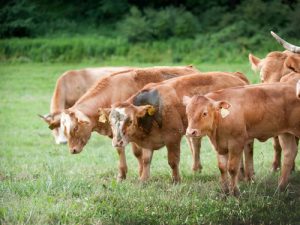According to the Statistical Office of the Republic of Slovenia, both the number of farms and the areas involved in organic production are increasing. Due to natural conditions, organic cattle breeding is most popular type of organ- ic farm activity. The organic beef production is the main activity on the Kosec and Zadravec farms, located in the northeastern part of Slovenia in the area of Prlekija. Due to difficulties encountered in the sale of organic cattle and organic beef meat, the Kosec farm started direct sales of organic beef in 2009. In the promotion and marketing of young organic beef, the farm co-operated with a major organic livestock farm owned by Zadravec.
Area: cca 70 ha of orchards
Relatively young farmers operate both farms and this contrasts with the overall situation in Slovenia. This is also reflected in the development of farms that have undergone many changes over the past decade. From redirection of production, acquisition of organic certificates, investment, modernization, changes in soil treatment technology, introducing pasture , introducing a brand for hay meats and joint marketing and product promotion. The main activity of farms is the production and sale of organic beef, but they are engaged in or develop other activities such as tour- ism and the production of organic cereals.
Cooperation Process Data
The partnership’s cooperation revolves around the joint sale and promotion of organic beef. The breeders found that the traditional practice of selling live animals for slaughter would not bring economic effects and that such a busi- ness model does not guarantee the sustainable and on-going development of farms.
They found that by direct selling to the end-users achieves a better price for their quality products. Such a method of sale requires the continuity of supply and care of customers, for which it is necessary to ensure an adequate stock of animals and appropriate quality controls that meets the needs of end users. It also requires on-going communi- cation, coordination, preparation and good logistics, as the advantage of their offering is in the freshness and taste of products.
They intend to maintain their competitive advantage into the future with a strong brand name, quality packaging and new forms of packaging (e.g. vacuum packing of fresh meat). They also undertaken market research in order to gauge future consumer trends.
Sales revenue grows from year to year, and new challenges are coming up with respect to growth. Contact with customers takes place at various events. They maintain a web site through which their products can be ordered. Schools and other public institutions are an important focus of marketing strategies.
Both farms have a vision of pursuing further developments over the next 10 years. In doing so, they are cooperating with all relevant stakeholders who shape agriculture policy; and scientific, educational and professional institutions. They utilize funds secured from various measures associated with the Rural Development Program.
They represent a sample of farms who have transformed from being a traditional production-oriented enterprise to an innovative and specialized farm, thereby providing value-added to the commodities produced on the farm.
The partners estimate that they have gained most of their knowledge from personal experience. It is important to communicate with a wide network of agricultural experts and institutions and customers. These farmers perceive educational initiatives such as lectures, workshops and seminars as outdated due to the time requirements asso- ciated with them. The Web seems to be a more useful source of information with respect to new developments in the field of agriculture and an appropriate communication tool. It should be better utilized for knowledge transfer. Browsing the web also requires a lot of time, so tools should be available that would be tailored to the needs of specific individuals or small groups. They would be interested in content about trends in sales and consumption of beef, consumer and consumer behavior, changes in sales channels for the sale of meat, events where they come in direct contact with consumers, and direct marketing.
Advice/Recommendation
“You need to ask yourself what you like to do and what the competitive advantages of your farm are.
You have to believe what you are doing and have to work with pleasure.
You have to have vision and goals, but also operational plans to do this.
You do not know everything alone, so you need to listen to others and to work with the right experts.”
Queries/Questions
- Do you think farmers can successfully cooperate together even if they do not merge into formal structures such as cooperatives, societies, companies?
- Should farmers’ education be better adapted to the personal needs of individuals and small groups?
- Would you use online courses which relate to the direct sale of agricultural prod- ucts?



 Čeština
Čeština  English
English  Français
Français  Deutsch
Deutsch  Italiano
Italiano  Slovenščina
Slovenščina  Español
Español 



